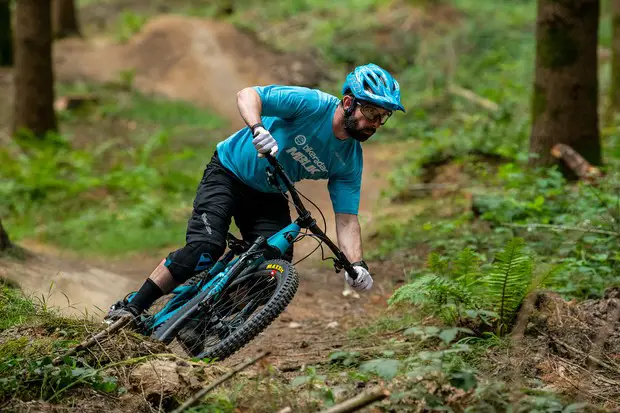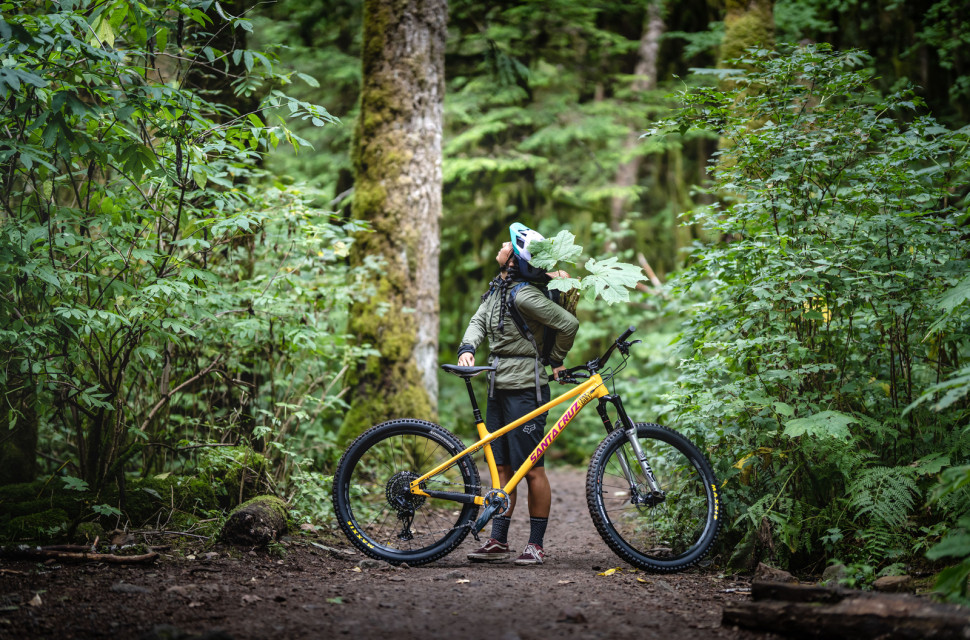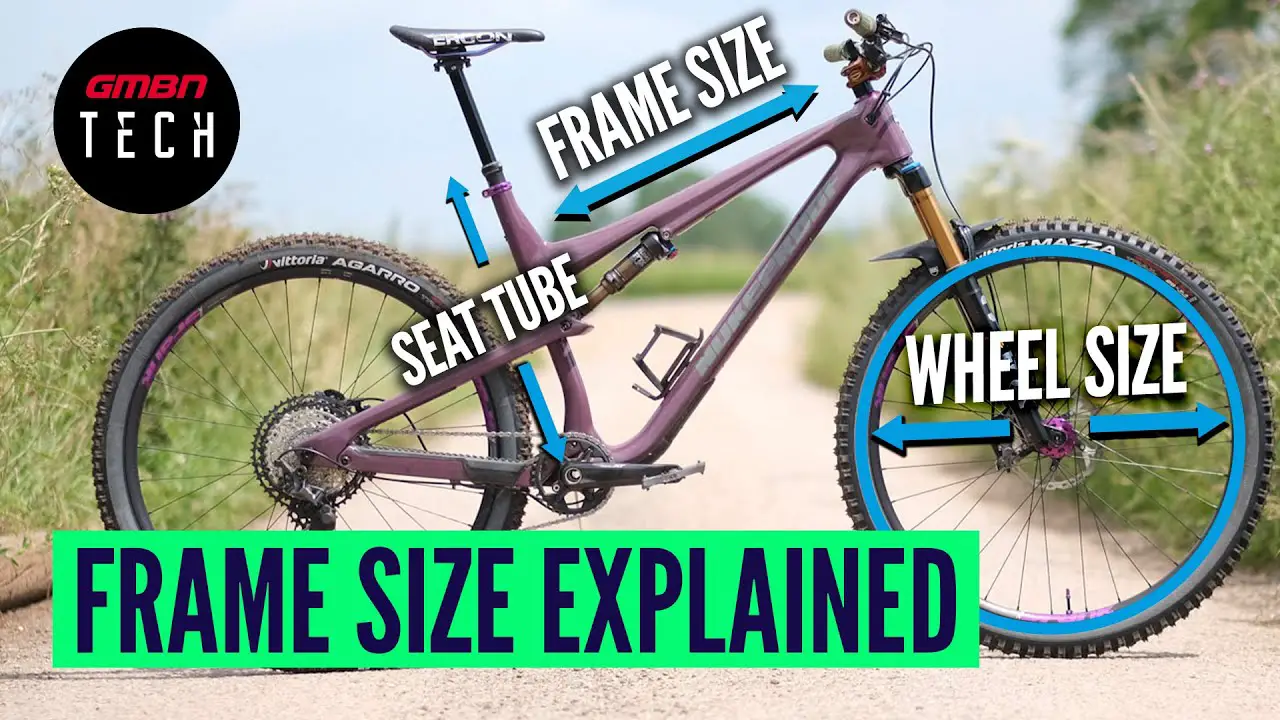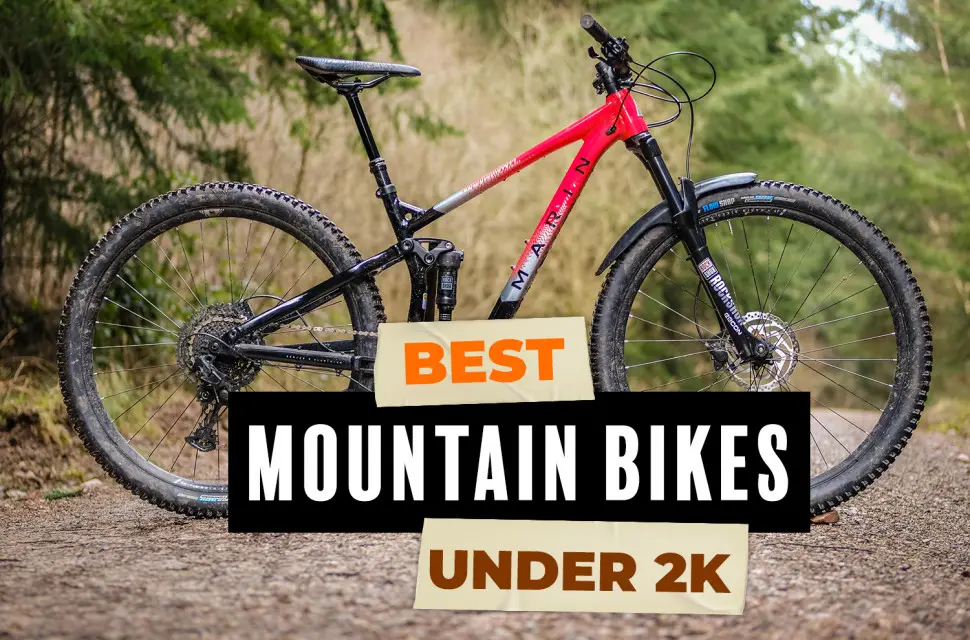Downcountry vs Trail Bikes: Choosing Your Perfect Ride!

As an affiliate, we may earn from qualifying purchases. We get commissions for purchases made through links on this website. You can read more on our Affiliate Disclaimer here.
Downcountry Vs Trail! Downcountry bikes blend cross-country efficiency with trail bike agility. Trail bikes prioritize versatility and durability for challenging terrains.
Mountain biking enthusiasts often grapple with the choice between downcountry and trail bikes. Downcountry bikes, a newer category within the sport, offer lighter frames and efficient pedaling akin to cross-country models but with added suspension for tackling rougher trails. This makes them a boon for riders looking to cover large distances with some technical complexity.
Also Read: Mountain Bike vs Road Bike
Trail bikes, on the other hand, stand out with their robust construction, longer suspension travel, and geometry designed for confident handling on demanding descents. They remain the go-to for cyclists craving a balance between climbing proficiency and descending prowess. Choosing between these two types depends largely on your riding style, the terrain you frequent, and the priority you place on speed versus stability.
Understanding Downcountry Bikes
Before we dive into the nuances of downcountry bikes, let’s set the stage for what these machines are designed to do. Bridging the gap between the lightweight prowess of cross-country bikes and the resilience of trail bikes, downcountry bikes bring forth a new blend of speed, agility, and capability. They epitomize the evolution of mountain biking by meeting the demands of riders seeking both uphill efficiency and downhill confidence. Let’s explore the essence of downcountry bikes.
What Are Downcountry Bikes?
Downcountry bikes emerge as the quintessential solution for mountain bikers who crave a rig that can attack climbs and revel in the thrill of descent with equal flair. These bikes take their genetic blueprint from cross-country (XC) platforms, adding just the right touch of trail-ready traits. With downcountry models, manufacturers strike a calculated balance, delivering lightweight bikes that don’t shy away from rougher trails and occasional airtime.
Characteristics And Features
At the heart of downcountry bikes are several distinctive characteristics that define their versatile performance:
- Lightweight Frame: Typically constructed from high-grade carbon or alloy materials.
- Increased Suspension: Offering 120-130mm of travel, surpassing traditional XC bikes for improved shock absorption.
- Geometric Tweaks: Slacker head angles and longer reaches for stability during descents, paired with steeper seat angles for efficient climbing.
- Wheel Size: Predominantly rolling on 29-inch wheels, optimizing rollover capability and momentum retention.
- Tire Choices: Equipped with tires that find a middle ground – not as skinny as XC tires and not as beefy as trail variants, resulting in an optimal mix of speed and grip.
This careful concoction of features puts downcountry bikes in a league of their own, ready to pounce on a varied range of mountain biking endeavors.
Suitable Terrain For Downcountry Bikes
Downcountry bikes excel in a unique landscape of terrains that demand both precision and power. They are the Swiss Army knife of the mountain biking world – adept in handling:
- Flowing Singletracks: The bread and butter of downcountry rides, perfect for their balanced traits.
- Technical Climbs: With their efficient pedaling and lightweight build, ascending challenging trails becomes more manageable.
- Moderate Descents: The added suspension and confident geometry lend themselves to tackling descents with poise.
- Twisty Forest Paths: Nimble handling characteristics make maneuvering through tight turns a breeze.
- Undulating Terrains: The versatile nature of downcountry bikes means they can maintain pace and comfort across varying elevations.
Whether you’re weaving through tree-lined trails or pushing the pace on cross-country adventures, downcountry bikes invite you to redefine the boundaries of your riding experience.
Exploring Trail Bikes
Within the adrenaline-pumping world of mountain biking, the quest for the perfect ride is unending. Trail bikes sit in a category that promises versatility and fun, suited for those who seek the thrill of descents and the challenge of climbs. A trail bike is an all-rounder, the Swiss Army knife of the mountain biking realm. As you understand more about what a trail bike offers, you will appreciate its role as a go-to choice for riders who value a balanced mountain biking experience.
What Defines A Trail Bike?
Trail bikes are characterized by their middle-of-the-road approach to mountain biking. They aren’t as aggressive as enduro bikes nor as steep-angled as cross-country bikes, which makes them ideal for a wide spectrum of trails. Typically, these bikes sport a moderate amount of suspension travel, ranging from 120mm to 140mm, striking a balance between uphill efficiency and downhill capability. Frame geometry is such that it provides a comfortable and responsive ride for both climbing and descending.
Key Features And Components
- Suspension: Dual suspension setup for a plush ride.
- Wheel Size: Commonly found with 27.5″ or 29″ wheels for optimal rolling over obstacles.
- Frame Geometry: Designed to enhance rider control and comfort over varied terrain.
- Tire Tread: Versatile patterns for grip in varying conditions and trail types.
- Brakes: Reliable and robust, typically hydraulic disc brakes for consistent stopping power.
- Drivetrain: Usually feature a wide-range of gears to tackle climbs and sprints with ease.
The components found on trail bikes are thoughtfully selected to offer a harmonious blend of agility, stability, and endurance. The innovation in the design and technology of these bikes means that they’re equipped to handle a variety of terrain while still providing a ride that’s invigorating and trustworthy.
Advantages And Limitations
| Advantages | Limitations |
|---|---|
| Great all-around capabilities Equally suitable for climbs and descents Responsive and comfortable geometry Ample suspension travel for most trails | Not as light as cross-country bikes May not handle extreme terrain as well as enduro bikes Limited racing advantage against specialized bikes Can be a jack-of-all-trades, but master of none |
Trail bikes offer a fantastic middle ground for those unbound by the niche constraints of other mountain bike categories. The versatility of a trail bike can be its biggest advantage, although it comes with trade-offs in weight and absolute performance on the very edges of mountain biking disciplines. Understand your riding goals and preferences to gauge whether a trail bike aligns with your mountain biking aspirations.
Performance Comparison
When debating the merits of Downcountry versus Trail bikes, the Performance Comparison takes center stage. Each riding style has enthusiasts pushing their limits, chasing speed through the singletracks or conquering technical ascents. Let’s delve deep into their performance characteristics, breaking down the critical areas: Speed and Efficiency, Climbing Capabilities, and Handling and Control. This insight helps riders make informed decisions, aligning their passion with the perfect machine. Boldly woven designs of engineering and purpose, both Downcountry and Trail bikes are poised to offer experiences tailored to the zeal of the rider.
Speed And Efficiency
Downcountry bikes are designed with lightweight frames and a focus on speed, making them highly efficient on varied terrain. They blend cross-country agility with a touch of trail robustness. Here’s how the two compare:
- Aerodynamics: Downcountry’s streamlined profile cuts through the air with ease, enhancing speed.
- Weight: Typically lighter than Trail bikes, they require less energy to propel, boosting efficiency.
- Rolling Resistance: Downcountry bikes often feature faster-rolling tires optimized for speed.
Climbing Capabilities
Ascending a steep incline is where the comparison intensifies. Trail bikes, with their rugged build, encounter climbing with a sense of assurance. Contrastingly, Downcountry steeds prioritize nimbleness and agility. The differences manifest in:
| Aspect | Downcountry Bike | Trail Bike |
|---|---|---|
| Suspension | Short-travel, stiffer for efficient power transfer | Long-travel, plush for technical ascent |
| Geometry | Upright position, favors quick maneuvering | Relaxed angles, stable on steeper climbs |
| Gearing | Higher range, suited for variable slopes | Lower range, powerful for sustained climbs |
Handling And Control
The definitive test of a bike’s character lies in its handling and control. Trail bikes shine with their stability in challenging terrains, thanks to their heft and suspension. Downcountry rigs respond with a feathery touch and precision. Consider the following:
- Steering: Trail bikes provide a planted feel, whereas Downcountry syncs with the rider’s reflexes for sharp turns.
- Balance: Trail versions offer a forgiving balance on technical sections; Downcountry prioritizes poise and responsiveness.
- Shock Absorption: With more travel, Trail absorbs more bumps; Downcountry applies a less-is-more philosophy.

Credit: off.road.cc
Considerations For Choosing The Right Bike
Choosing the right mountain bike can turn a good ride into a great adventure. Given the variety of mountain biking disciplines, it’s crucial to consider your unique needs when deciding between a downcountry bike and a trail bike. The following sections will guide you through key considerations, helping you select the perfect bike for your adventures.
Riding Style and Preferences
Riding Style And Preferences
Personal riding style plays a pivotal role in selecting the right bike. A downcountry bike is designed for riders who crave speed, efficiency, and agility, usually on smoother terrain. In contrast, a trail bike offers comfort and versatility for those who enjoy tackling diverse trails, from flowy to technical sections.
- Downcountry Bikes: Best for cross-country rides with an adventurous streak.
- Trail Bikes: Suited for a broad spectrum of trails with an emphasis on downhill performance.
Terrain and Trail Types
Terrain And Trail Types
The terrain you plan to conquer should influence your decision significantly. Downcountry bikes excel on less demanding terrains that require bursts of speed and efficient pedaling. Trail bikes, equipped with greater suspension, are made for rugged terrains and steeper descents. Consider the typical trails you’ll encounter before making your choice.
| Trail Type | Downcountry Bike | Trail Bike |
|---|---|---|
| Cross-Country | Optimal | Capable |
| All-Mountain | Capable | Optimal |
| Technical Downhill | Challenging | Superior |
Personal Fitness and Skill Level
Personal Fitness And Skill Level
A rider’s fitness and skill level are key to enjoying the mountain biking experience. Downcountry bikes require a certain level of fitness for efficient pedaling and handling, particularly on long rides or races. Trail bikes, being more forgiving, cater to a wider range of skill levels and can help newer riders build confidence on challenging trails. Select a bike that matches your current capabilities while also offering room for growth and improvement.
- Assess Personal Fitness: Are you ready for the physical demands of a downcountry ride?
- Consider Skill Progression: Do you seek a bike that grows with your abilities?
- Match Bike to Skill: Will the bike enhance your current mountain biking skills?
Making The Best Decision
The journey from pedal push to summit drops brings us to our pivotal moment: Choosing between Downcountry and Trail mountain biking. It’s clear that each style offers a distinctive ride, tailored to certain terrains and rider preferences. This final section will guide you through the essential factors to deliberate, consult with seasoned riders and experts, and solidify your decision for a biking experience that resonates with your riding aspirations and lifestyle.
Decision-making Factors
Personal riding style and terrain preferences sit at the heart of your decision. Reflect on these elements:
- Elevation Changes: Downcountry excels in rolling terrains, whereas Trail bikes are built for steeper, more aggressive topographies.
- Tech Specs: Compare suspension, tire width, and frame geometry to ensure they align with your anticipated adventures.
- Fitness Level: Trail bikes might demand more physical input; choose a bike that compliments your endurance and strength.
Seeking Expert Advice
Connect with experienced riders and professionals in the sport. Their insights can be invaluable. Forums, local bike shops, and rider groups serve as excellent resources for unbiased advice.
Consult product reviews and comparisons, often rich in detail, to gain a clearer perspective on how each bike type has performed in real-world conditions.
Finalizing Your Choice
Having weighed personal preferences against expert counsel, you’re ready to choose. A practical step is demo rides: nothing compares to real-time testing. Make use of demo programs at bike shops or events to get a literal ‘feel’ for your options.
Consider longevity and future-proofing—will your choice stand the test of changing trends and growing skills? Invest in versatility, quality, and a bike that brings joy with every ride.
Frequently Asked Questions On Downcountry Vs Trail
What Is Downcountry Biking?
Downcountry biking refers to a lightweight, versatile mountain biking style primarily featuring climbs and cross-country travel with occasional aggressive downhill segments. It merges the climbing efficiency of cross-country bikes with some of the technical capabilities of trail bikes.
How Does Trail Biking Differ From Downcountry?
Trail biking places more emphasis on the downhill performance and technical trail features, with bikes designed for greater suspension travel and durability than downcountry bikes. These bikes are tailored for a mix of climbing and descending with a slight preference for the latter.
Can A Downcountry Bike Handle Rough Trails?
A Downcountry bike can handle moderately rough trails but is optimized for speed and efficiency on less demanding terrains. Its suspension and frame are not designed for the most extreme or technical trails where a full trail or enduro bike would excel.
What’s The Ideal Suspension Travel For A Downcountry Bike?
Ideally, a Downcountry bike has suspension travel between 100mm to 120mm. This provides a balance between climbing prowess and the ability to handle occasional technical descents without the weight penalty of larger suspension systems.
Conclusion
Navigating the choice between downcountry and trail bikes can be thrilling. Each has distinct strengths tailored to specific terrains and riding styles. Whether you crave the agility of downcountry rides or the robust resilience of trail adventures, your decision will pave the way to unforgettable journeys.
Embrace the bike that aligns with your passion and let the thrill of the ride dictate your path.

Steven is a professional cyclist and his passion is cycling. He has been cycling for the last 6 years and he loves using bikes while outing as well. Based on his experiences with the different types of bikes; he is sharing his opinions about various bikes so that a beginner can start right away. Find him on Twitter @thecyclistguy Happy Biking.




